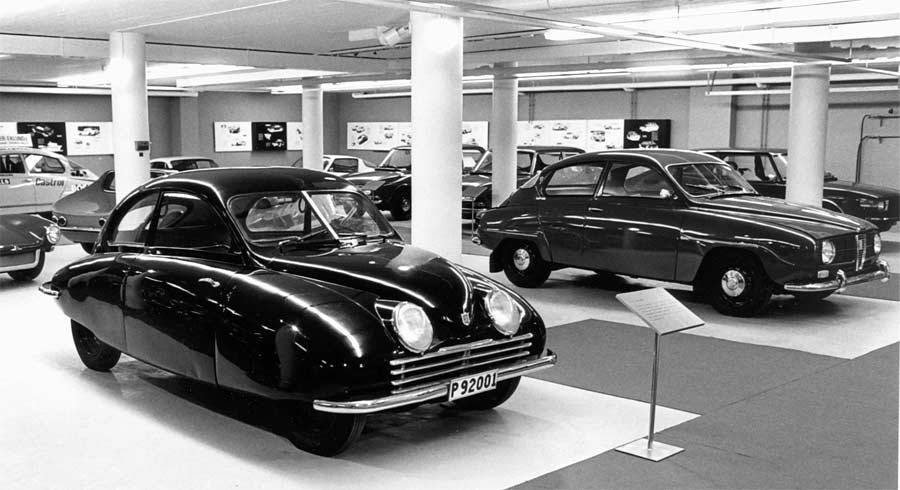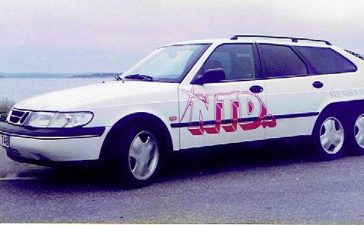About ten years ago, a Philadelphia-based local American acr journalist of “Philadelphia Examiner” John Matras was impressed with his visit to Saab Museum in Trollhattan. After the visit, Matras wrote an interesting report for his newspaper on visiting the Saab Bilmuseum in Trollhattan. If you’ve never gone and are considering a visit, check out this feature where he shares a hint at what you will find.
Museum at the center of the Saab fan’s world
The center of the earth for Saab enthusiasts is a place called Trollhättan, a small city in southern Sweden on the Göta alv River, named for the islands that local inhabitants had thought looked like hats—hattör—worn by the giant trolls who lived under the water. Saabistas don’t necessarily share the belief in the trolls, but they hallow the burg as the origin off all things Saab automotive. It’s the home of the original Saab automobile factory.
Nowadays Saab cars are made in several locations, the automotive division purchased by General Motors—trucks and aircraft divisions going their separate ways in a rather convoluted corporate history—but Saab headquarters still resides in Trollhättan and European delivery still takes place there. However, for the ordinary Saab fan—if “ordinary” and “Saab” don’t constitute an oxymoron—the true reason for a pilgrimage to the city on the Göta alv is the Saab Bilmuseum, bil of course being the Swedish word for automobile.

The museum documents the sixty years of Saab automobiles with a collection of important Saabs, including the 1947 Saab 92.001, the actual first Saab prototype powered by a pre-war German DKW two-stroke twin with body panels from “surplus” SAAB aircraft parts. Designed by aeronautical engineers—who with true engineer hubris concluded that making a car should be easy compared to making an airplane—the teardrop shaped 92.001 was unlike anything that existed at the time.
Or since, for that matter, unless one considers the production Saab 92 that followed. One of these initial Saabs, nicknamed “the toad” for it contours and typical dark green color, is in the museum, and in fact the one we have driven. Despite its slow whirring acceleration and popping cruise from the two-stroke twin cylinder engine of Saab design, the 92 was an easy cruiser on rural Swedish roads.
The 92 was followed by the 93—Saabs at that time were simply given their engineering project number as a name—largely similar to its predecessors but with three instead of two cylinders.
And that was just the beginning. The Saab Bilmuseum documents Saab automobile history with a sample of every car model, including the 95 (a station wagon), the 96 (a further development of the original teardrop sedan), and the 99 (another sedan). Note that there’s no 94 nor 97 which were aircraft projects, nor 98, a stillborn. To stay with the “9” theme, the next series was dubbed 900, and the series after that, 9000. Because 90000 would simply be ridiculous, Saab adopted the current 9-3/9-5/etc. nomenclature.
No matter. The Saab Bilmuseum covers ’em all, plus all three generations of Sonnetts, various racers and rally cars, and The Monster. The latter was a Saab 93 with two three-cylinder two-stroke engines grafted together end-to-end with power taken off a spur gear in the middle. Intended to race against the rear-engined Porsches of the Fifties, The Monster was frightfully fast and ungodly loud but where the Porsches were in perpetual danger of spinning out, The Monster responded to inducements to turn by breaking. It remains a glorious one-off.
Another competition car is a one-of-two, an open-wheel Formula Junior that was fast in a straight line but again, with 70 percent of its weight on the front wheels, it understeered relentlessly. No wonder Saab stopped at two.
The Saab Bilmuseum also has a comprehensive collection of a Saab’s giant-killing rally cars, including a replica of Eric Carlsson’s Monte Carlo-winning Saab 93, fully outfitted with all of the driving lamps and fully kitted with all the extra supplies in the proper custom-fit holders.
And engines? Two rows of them on engine stands, one of every engine made or used by Saab.
What the Saab Bilmuseum lacks, however, is almost any reference to Saab’s aircraft heritage (though there’s an extensive aircraft museum in nearby Linköping) or Saab-Scania, the heavy truck manufacturing that came and left from Saab automobile’s orbit.
The museum is also rather sterile, with cars simply “parked” rather than displayed, and there is very little Saab mobilia, the miscellaneous artifacts that flesh out an exhibit. However, there’s limited space available so the curators have obviously chosen to show as many examples as possible, if at the expense of pretty dioramas, and the cars are approachable, with not a “rör inte” sign in sight…though it’s expected that you’ll not touch. The museum is also bright and airy, with tall windows on one side, making photography possible without flash, at least during daylight hours.
Our greatest disappointment, then, was wanting to see more. After all, it’s the center of the earth, and the trolls wouldn’t want to have it any other way
Getting there: Set your navigation system to Åkerssjövägen 10, Trollhättan, at least if your nav system in in English (and you are too) Otherwise, from highway Rv 45, follow the signs to Innovatum/Saab Bilmuseum, or if you can find a trustworthy map, find Innovatum and make like a Boy Scout.











